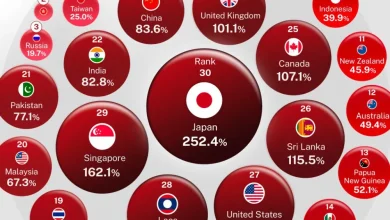2024’s Economic Surge: Top Fastest Growing Countries in Europe

Despite recent difficulties including inflation and international geopolitical concerns, a number of European nations are anticipated to see significant economic development in 2024.
Malta’s GDP is expected to rise by about 3.3%, while Romania’s GDP is expected to grow by about 3.8%, making both countries stand out as having some of the fastest-growing economies.
Spain is also anticipated to experience consistent growth, propelled by a resurgence in investment and consumer expenditure. These growth patterns point to a more widespread European recovery, bolstered by strong domestic demand and lower inflation.
Important Takeaways
Malta’s economy is focused on services, such as banking and tourism services, which rank first on the list. It also emphasizes exports from the manufacturing sector, namely from pharmaceuticals and electronics.
With 13% of Malta’s exports going to Germany, the country is its largest economic partner.
In 2024, the services sector—primarily trade, tourism, catering, and construction—has propelled Serbia’s economy forward.
Russia’s economy has expanded despite sanctions thanks to commerce with China and India and the rise of domestic companies that have displaced Western ones.

Real GDP growth rates in Europe 2024
Spain: A rebound in tourism and more consumer spending are expected to fuel the country’s 1.5% growth.Advisor Channel.
Romania: Driven by domestic and industrial investments, it is predicted to have one of the greatest growth rates, at about 3.8%.Finance and Economics.
Malta : is expected to grow by 3.3% thanks to a robust service sector and a rebounding tourism industry.Finance and Economics.
Slovakia: Industrial production and EU funding support are expected to boost the country’s 2.5% projected growth rate (ADVISOR CHANNEL).
Sweden: A slight gain of about 0.6%, indicating a slower rate of recovery brought on by interest rate increases and inflationary pressuresAdvisor Channel.
Growth in the UK is predicted to be 0.5%, driven by tight monetary policy and economic uncertainty.
Germany: The largest European economy is expected to have minimal growth or stagnation due to challenges in the manufacturing sector and energy costs
1. How has inflation affected Europe’s economic recovery?
Inflation has significantly impacted Europe’s economic recovery. The surge in energy prices following Russia’s invasion of Ukraine, coupled with supply chain disruptions, led to a sharp rise in inflation across the continent. This high inflation eroded consumer purchasing power, dampened business confidence, and increased uncertainty.
Central banks responded by raising interest rates to curb inflation, which slowed down economic growth. However, these measures have also increased the risk of a recession. Additionally, high inflation has put pressure on households and businesses, leading to increased borrowing costs and reduced investment.
Despite these challenges, Europe’s economy has shown resilience.
As inflation has begun to moderate, there are signs of a gradual recovery. However, the path to a full recovery remains uncertain, and the long-term impact of high inflation on Europe’s economy is still being assessed.
2. Which country has the brightest future?
Nations that prioritize economic resilience, technological innovation, and sustainable growth have bright futures. According to a number of international evaluations, countries with bright futures include Singapore, Iceland, and Luxembourg.
Luxembourg is a leader in progressive legislation and has established itself as a center for financial services and innovation. In the meantime, Singapore is well-positioned for the future because to its emphasis on technology and sustainable urban development.
With a robust economic outlook, emerging economies like India also exhibit enormous promise due to their sizable and youthful workforce, rising middle class, and embrace of technology.
conclusion:
In conclusion, the 2024 economic prognosis shows that a number of European nations are expected to have substantial growth. Due to robust domestic demand, rising investment, and an advantageous business climate, countries like Spain, Poland, and Ireland are anticipated to lead the pack. These nations are reaping the benefits of technology developments, improved infrastructure, and highly skilled labor as Europe recovers from the economic downturn. Even if geopolitical unpredictability and inflationary pressures could provide difficulties, overall growth trends suggest that these quickly growing economies are resilient and have opportunities. In 2024 and beyond, keep a watch on these countries as they continue to influence Europe’s economic future.
faqs:
1. Which European countries are expected to grow the fastest in 2024?
In 2024, Spain, Malta, and Romania are expected to have some of Europe’s fastest-growing economies. With a growth rate of more than 3.8%, Romania is predicted to lead, followed by Malta and Spain, whose economies are fueled by investment and consumer expenditure.
2. What factors are driving economic growth in Europe in 2024?
Reduced inflation, higher consumer spending, a rebound in travel, and robust corporate investment are important contributors. The economic expansion is also being aided by stable labor markets and supportive budgetary policies.
3. How has inflation affected Europe’s economic recovery?
Despite being a worry, inflation has gradually decreased, which has increased consumer spending and confidence and aided regional recovery efforts. Inflationary pressures have also decreased due to lower energy prices.
4. Are geopolitical risks impacting Europe’s economic growth?
Indeed, there are still hazards associated with geopolitical conflicts and global uncertainties. To combat possible disruptions, some European economies have demonstrated resilience by expanding domestic investment and diversifying their trade.



